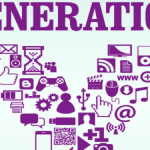There are many types of systems of thinking in today’s organizations, and as new generations start entering the market place, leaders need to be aware of the strategies they’ll need to succeed, especially when dealing with millennials (those born between 1980-2000) and their expectations of the work environment. According to Dr. Gareth R Jones, a professor of Management at Texas A&M, organizations have to stay abreast of change and innovation if they want to survive in this ever changing business world. Following is an introduction of the employee-driven paradigm, its relation to millenials, and how this new paradigm is going to help improve the success of this generation and ultimately the success of the organizations they are a part of.
New Paradigm – Employee-Driven Paradigm (Millennials)
According to Harold Greenwald (2008), leadership occurs in many forms, but ultimately boils down to two capabilities: (1) selecting among alternative courses of action and (2) bringing and keeping employees on board. It is so important for leaders to know what they need to do and how to gain the trust and manage the people around them to meet and exceed the goals of the organization. With these new generations entering into the work force, especially millennials, leaders have to be equipped to work with these employees to help them succeed while also making sure that the organization’s goals are being met.
Introducing the Employee-Driven Paradigm will meet the needs of the evolving views of the future business trends. According to CS Alexander (2013), millennials are treating technology as their “sixth sense.” So this new paradigm will need to have a major focus on technology. The employee-driven paradigm will include flexible work schedules, access to as much technology as needed to get the job done, specific goals laid out on a monthly basis for employees to know what they need to do and their goals, and, most importantly, the ability to allow employees to hold themselves accountable to their goals. The employee-driven paradigm offers employees an open system for them to operate in while still being steered by a leader, along with the ability to conduct their job as though they were running their own business. Dr. Donald R Brown explains that there are 3 emerging future trends in organizational development: macro-system trends, interpersonal trends and individual trends. The employee-driven paradigm, focusing mainly on the millennial generation, is going to encompass these trends and greatly encourage interpersonal and individual growth.
There are 5 areas that Brown (2011) mentioned which are crucial to the interpersonal trend. The first: merging line and staff functions in turn helping create a flatter organization where everyone is more involved in coming up with a plan and everyone is vested in the performance of the team; second, linking resources among teams; third, integrating quality and productivity and productivity needs to result into quality for the organization to succeed; fourth, diversity; and fifth, networking and finally rewarding (Brown, 2011). All these areas will be covered under the employee-driven paradigm as employees will be given much more autonomy to get their job done and be held responsible both as an individual and as a team.
Employees will be at the center of this new paradigm and, as mentioned by Brown (2011), the individual trend emphasizes the singular person, helping the individual feel empowered to do their job (Brown, 2011). Inside the individual trend are five important areas implemented in the employee-driven paradigm. These include: intrinsic worth, growth of the individual, effects of thinking, health and fitness and interdependence (Brown, 2011).
Dr. Jones stated that “Over time, in an organic structure, specific norms and values develop that emphasize personal competence, expertise, and the ability to act in innovative ways”. With the employee-driven paradigm, each individual will be focused on achieving their own goals. Moreover each employee will possess flexibility, working in a less confined environment with just the right amount of structure so that they can get their job done while having an environment where they valued. Likewise, they’ll know that the organization is keeping both their physical and mental health in mind. In this new paradigm, individuals will also have the opportunity to create an improved work and life balance. Whether they work in the office or at home – or both – as long their goals are being met, the organization will succeed.
Ethical Considerations
One of the ethical issues that arises with this paradigm are whether standing employees already in the workforce will be disrupted. The employee-driven paradigm is based on trust and employees who are tenured might feel upset by the idea that new generations of employees are receiving benefits they themselves had not received when they first arrived in the organization. This might cause an imbalance within that organization’s culture between new and tenured employees. As a solution, leaders would need to work with every player in the organization to help create a new culture. Team members would need to learn how to work well with each other to create a dynamic work environment, regardless of the generational diversity present on the team.
Another area to take into consideration is the trust between employer and employee. With this new paradigm, employees will be given autonomy to get their work done and as long as their goals are being met. Leaders will have to learn how to take a hands-off approach while continuing to encourage them to perform. The issue which lies here is trusting that employees will be using the organization’s resources to meet and exceed their goals. It is going to be difficult for some leaders using the employee-driven paradigm to take that “leading from behind” approach.
Conclusion
According to Brown (2011) there needs to continue to be a focus on team development, team dynamics, and the importance of helping individuals feel that they belong to a team and are an integral part of an organization. Brown (2011) also explained that it will be critical to make sure that employees feel that they are part of something valuable. It is going to be more important now than ever to help employees feel that they belong. With the implementation of the employee-driven paradigm, organizations will be better positioned to offer the benefits and flexibilities needed for the newer generations entering today’s workplace. Organizations that are willing to incorporate such new paradigms will continue to stay ahead of the competition in meeting the demands of potential employees. They will be in a prime “position to succeed in the future” (Jones 2010).





